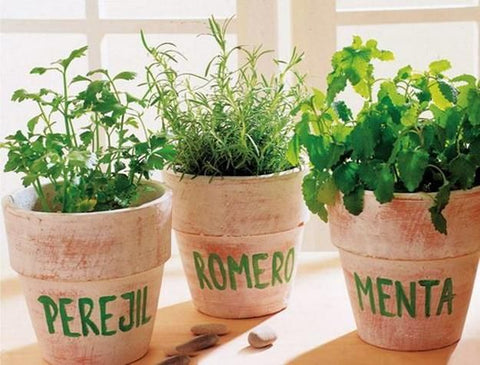A unique contribution to giving personality when it comes to seasoning that, on many occasions, we put aside thinking that they can only be grown in a garden and that we cannot enjoy their aromas without having a garden.
Before looking in detail at how to grow aromatic herbs at home, it is important to bear in mind that there are many culinary plants and, although some are very rustic, there are others whose cultivation is not so simple... although there are a good number of aromatic plants that we can grow inside the house, there are others that need to grow outside.
How to grow aromatic herbs at home - successfully.
Let's see what are the keys to knowing how to grow aromatic herbs successfully.
Location
Although each variety has its specific needs, there is one factor common to practically all aromatic plants, and that is their high demand for light, so we will have to choose a place where they have a minimum of five or six hours of light per day.
The drainage
Aromatic plants love regular watering, because excess water on their roots is an enemy of their well-being. We are not only referring to the need for drainage holes if they are planted in pots, but also to a good layer of water at the base of the planting site to help drain excess water.
The substrate
Not just any substrate will do for growing these plants. It is essential that we choose one specifically for the garden. In addition, choosing a substrate designed for food products guarantees that our aromatic plants are perfectly suitable for consumption. Not only will it provide the nutrients that these types of plants require, but it is also essential to promote proper drainage.

The container
It is important to choose from the different types of pots which are suitable for this type of plants and the best are clay pots, a material that facilitates the evaporation of excess water, a fundamental detail for this type of garden plants.
Another perfect option is vertical urban gardens, they are perfect for taking advantage of wall space and decorating any space with nature.
The temperature
Although some aromatic plants are resistant, the vast majority of them do not like cold or excessive heat, so we must be careful with excessive heat and cold.
Planning
When growing aromatic plants indoors, we cannot grow just any species; we will opt for the most resistant species, which are the most likely to grow in indoor environments.
Once we have decided which aromatic plants to grow at home, we will have to consider their life cycles . While some are perennial, others have shorter cycles of one year or two years at most. These times largely determine their grouping when planting.
A very useful method of crop planning is to group aromatic plants by watering requirements.
Pruning
While it is important to know each plant, annual herbs will require pruning at the end of the season. How do you know when this time comes?
Simple: when flowering ends, by removing wilted flowers, we will be helping the plant to revitalize itself and grow stronger the following season.
Combine different plants
Although seedlings (small plants that we buy at the market or in a garden) allow us to enjoy plants from the first moment, the ideal is to combine them with seeds, since we can combine slow-growing perennial seedlings with others with an annual or biennial cycle that grow faster in seeds. The main advantage of the latter is that we do not have to wait long for them to grow and they will be acclimatized to the growing space from the beginning.
Harvest
Cutting twigs from time to time is a fantastic way to promote plant growth, but always in moderation, and without depleting it. So don't be afraid to take a twig from your aromatic plant from time to time to season a dish. Without knowing it, you will be helping it to grow stronger and more vigorously.

The best plants to grow in your home
Chives are one of the most recommended aromatic plants to grow indoors. They stand out for their particular onion flavour, although their aroma is milder. According to a publication in Phytotherapy Research , they are a source of vitamin C, soluble proteins and antioxidants.
In terms of cooking, it is recommended for seasoning fish, meat and soups. It can also be incorporated into salads and recipes with vegetables. The best thing? Its maintenance is not complicated. It requires little sun – about two hours of direct light are enough – and it adapts easily to indoor conditions.
Dill (Anethum graveolens)
It is ideal for giving more flavor and aroma to salads, sauces and fish, among other preparations.
It is also known for its medicinal properties. A study shared in Pharmacognosy Reviews shows that it has anti-inflammatory, antioxidant, diuretic, carminative, stimulant and stomachic properties.

As for its care, it requires direct light. Therefore, when planting it inside the house, it is ideal to place it near a window or another light source. Its watering must be moderate and the substrate must have a good drainage system.
Lavender (Lavandula angustifolia)
Its aroma is relaxing and gives a feeling of freshness . In fact, it is believed to help repel insects, such as mosquitoes.
What has been proven is that it contains volatile oils that help calm stress and anxiety. In addition, an article published in Evidence-Based Complementary and Alternative Medicine determined that it has potential as a natural anti-inflammatory.
When growing this plant, it is important to consider that the pot must have a good drainage system. Lavender is quite sensitive to excess water. In fact, it is enough to water it once a week or until the substrate dries out.
Coriander (Coriandrum sativum)
A study shared on Food Research International classified cilantro as a functional food with promising properties for well-being. This, in reference to its content of bioactive compounds with antioxidant, anti-inflammatory, neuroprotective and anxiolytic effects, among others.
Its aroma is strong, as is its flavor and it combines very well with meats, soups, salads, legumes and fish.
Growing it indoors is relatively easy, just add a mixture of peat and sand to a pot with a good drainage system. It does not need to be watered regularly and you have to wait until the soil is dry.
As for light, it requires about 4 or 5 hours of sun daily, although the ideal is to have it near a window.

Thyme (Thymus vulgaris)
Thyme is known for its contributions to health. Heliyon highlights its anti-infectious, cardioprotective, gastroprotective, anti-inflammatory and immunomodulatory properties.
It is also a very versatile ingredient, as it adds flavour and aroma to meat dishes, stews, vegetables and soups. As far as its care is concerned, it requires direct sunlight and air currents. In interior spaces it should be kept near windows to ensure these conditions.
As with other plants, it is essential to ensure good drainage, as well as good substrate and humus.
Sage (Salvia officinalis)
Fresh or dried sage is used to season meats, fish and vegetables. Beyond this, it is valued for its medicinal qualities , as it is a source of carbohydrates, fatty acids, phenolic compounds and trace elements that benefit health.
To grow it indoors, you need to know that it requires sufficient sunlight, and should be exposed to sunlight for 6 to 8 hours a day. A sandy substrate and a large container are recommended.

Basil (Ocimum basilicum)
It has a soft and pleasant smell that can be used in dishes such as pasta (in pesto sauce, for example); it can also be included in salads, soups and meat recipes.
Regarding its health benefits, a review shows that it contains polyphenols and flavonoids that contribute to improving the quality of the diet. These give it anti-inflammatory, antioxidant and chemopreventive effects.
It can be grown both outdoors and indoors. However, it requires a lot of sunlight. Its humidity must be well controlled, since too much water easily rots its roots. To enrich its soil with nutrients, it is advisable to use organic fertilizers.
Spearmint (Mentha spicata)
It is used to marinate meats and to enhance the flavour of salads and vegetable recipes. Some people even use it in cocktails.
According to an article in Evidence-Based Complementary and Alternative Medicine , peppermint contains antioxidants, essential oils, vitamins and minerals that are linked to good health. It is used to prevent chronic diseases, combat obesity and protect cognitive health.
Ideally, it should be grown indoors in a semi-shaded environment, as too much sunlight tends to burn its leaves. Its watering should be moderate, except in summer, when it should be more regular.




Comments (0)
There are no comments for this article. Be the first one to leave a message!